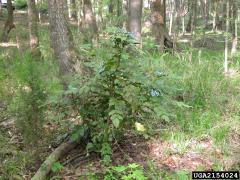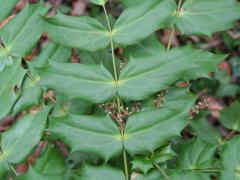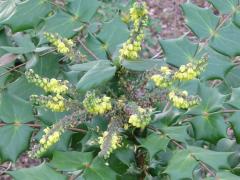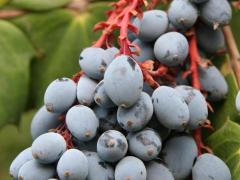Invasive Species: Mahonia bealei, Leatherleaf Mahonia
Leatherleaf mahonia is an invasive evergreen shrub that can grow from 5 to 10 ft (1.5 to 3 m) tall. Leaves are pinnately compound and 18 in. (46 cm) long, with 9 to 13 holly-like leaflets. Leaflets are 2 to 4 in. (5 to 10 cm) long and 1 to 2 in. (2.5 to 5.1 cm) wide. Flowering occurs in late winter and early spring, when fragrant, lemon-yellow flowers develop. The fruits are green berries, about a half inch long, that turn bluish black with a grayish bloom. Fruits hang in grape-like clusters. Leatherleaf mahonia is native to China. It has been planted as an ornamental shrub and is now invading woodlands in the Southern United States.
What are invasive species, and why should we be concerned about them?
Taxonomy: Scientific and Common Names for This Species
Ranunculales > Berberidaceae > Mahonia bealei (Fortune) Carr.
Synonym(s): Beale’s barberry
Mahonia bealei – USDA PLANTS Profile
Distribution Maps
leatherleaf mahonia – The reported distribution of this invasive species across the United States (Source: Invasive Plant Atlas of the United States)
Up-to-the-minute distribution maps and why they are important
Reporting This Invasive Species
What is the best way to report the occurrence of an invasive species?
How to report an invasive species sighting to EDDMapS – Early Detection & Distribution Mapping System
EDDMapS – Report an invasive species to EDDMapS.
County Extension Offices – Find your county Extension office on this map provided by USDA.
How to Identify
This invasive species can be identified by looking for the characteristics described in the paragraphs that follow.
Shrub
Leatherleaf mahonia is an evergreen shrub that can grow from 5 to 10 ft. (1.5 to 3 m) tall.
 |
 |
| Nancy Loewenstein, Auburn University, bugwood.org | James H. Miller, USDA Forest Service, bugwood.org |
Foliage
Leaves are pinnately compound and 18 in. (46 cm) long, with 9 to 13 holly-like leaflets. Leaflets are 2 to 4 in. (5 to 10 cm) long and 1 to 2 in. (2.5 to 5.1 cm) wide.
 |
 |
| Robert Videki, Doronicum Kft., bugwood.org | Robert Videki, Doronicum Kft., bugwood.org |
Flower
Flowering occurs in late winter and early spring, when fragrant, lemon-yellow flowers develop.
 |
 |
| Nancy Loewenstein, Auburn University, bugwood.org | Nancy Loewenstein, Auburn University, bugwood.org |
Fruit
The fruits are green berries, about a half inch long, that turn bluish black with a grayish bloom. Fruits hang in grape-like clusters.
 |
 |
| Nancy Loewenstein, Auburn University, bugwood.org | Robert Videki, Doronicum Kft., bugwood.org |
Native Species That Resemble Leatherleaf Mahonia
– Images at invasive.org
| bugwood.org | bugwood.org |
– Images at invasive.org
| bugwood.org | bugwood.org |
Additional Images for Leatherleaf Mahonia
leatherleaf mahonia – Images at invasive.org
Learning Resources for Leatherleaf Mahonia
Additional Information, Biology, Control and Management Resources
Control and management recommendations vary according to individual circumstances. Location, habitat, weather, and a variety of other conditions are factors that help determine the best treatment choice. To find the safest and most effective treatment for your situation, consult your state’s land-grant institution. If you will use chemicals as part of the control process, always refer to the product label.
United States Land-Grant University System – Find your Land-Grant University’s College of Agriculture, University Cooperative Extension Service, or other related partner on this map provided by USDA.
A Field Guide for the Identification of Invasive Plants in Southern Forests – USDA Forest Service
A Management Guide for Invasive Plants in Southern Forests – USDA Forest Service
Invader of the Month – Invasive Species of Concern in Maryland
